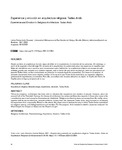Experiencia y emoción en arquitectura religiosa: Tadao Ando

Use this link to cite
http://hdl.handle.net/2183/30284
Except where otherwise noted, this item's license is described as Atribución-NoComercial-CompartirIgual 4.0 Internacional (CC BY-NC-SA 4.0)
Collections
Metadata
Show full item recordTitle
Experiencia y emoción en arquitectura religiosa: Tadao AndoAlternative Title(s)
Tadao AndoExperience and Emotion in Religious Architecture: Tadao Ando
Author(s)
Date
2021-12-21Citation
León Alvarado, L. S. (2021). Experiencia y emoción en arquitectura religiosa: Tadao Ando. Actas de Arquitectura Religiosa Contemporánea, 8, 90-99. https://doi.org/10.17979/aarc.2021.8.0.8851
Abstract
[Resumen] Desde su inicio, la arquitectura ha sido capaz de influir en la experiencia y la emoción de las personas. Sin embargo, a partir de la segunda mitad del siglo XX, la teoría de la arquitectura ha potenciado estos dos aspectos en aquéllos que dejan de concebirse como usuarios para reconocerse como habitantes. La arquitectura religiosa no escapa de esta realidad, puesto que, aunado a su carácter sagrado, está el hecho de que varios arquitectos, entre los que destaca el japonés Tadao Ando, se han concentrado en potenciar la vivencia desde la corporeidad. Con base en lo anterior, el presente documento tiene como objetivo analizar la forma en la que Tadao Ando materializa sus espacios religiosos, priorizando la experiencia y la emoción. Para ello, se analizan tres templos ubicados en Japón: la Capilla del Viento, la Capilla sobre el Agua y la Iglesia de la Luz. [Abstract] Since its inception, architecture has been able to influence the experience and emotion of people. However, since the second half of the Twentieth Century, the theory of architecture has enhanced these two aspects in those who cease to be conceived as users and recognize themselves as inhabitants. Religious architecture does not escape from this reality, since, together with its sacred character, several architects, among them the Japanese Tadao Ando, have focused on enhancing the experience from corporeality. Based on the above, this paper aims to analyze the way in which Tadao Ando materializes his religious spaces, prioritizing experience and emotion. For this purpose, three temples located in Japan are analyzed: the Wind Chapel, the Chapel on Water and the Church of Light.
Keywords
Tadao Ando
Arquitectura religiosa
Fenomenología
Experiencia
Emoción
Religious Architecture
Phenomenology
Experience
Emotion
Arquitectura religiosa
Fenomenología
Experiencia
Emoción
Religious Architecture
Phenomenology
Experience
Emotion
Editor version
Rights
Atribución-NoComercial-CompartirIgual 4.0 Internacional (CC BY-NC-SA 4.0)
ISSN
2659-8671






